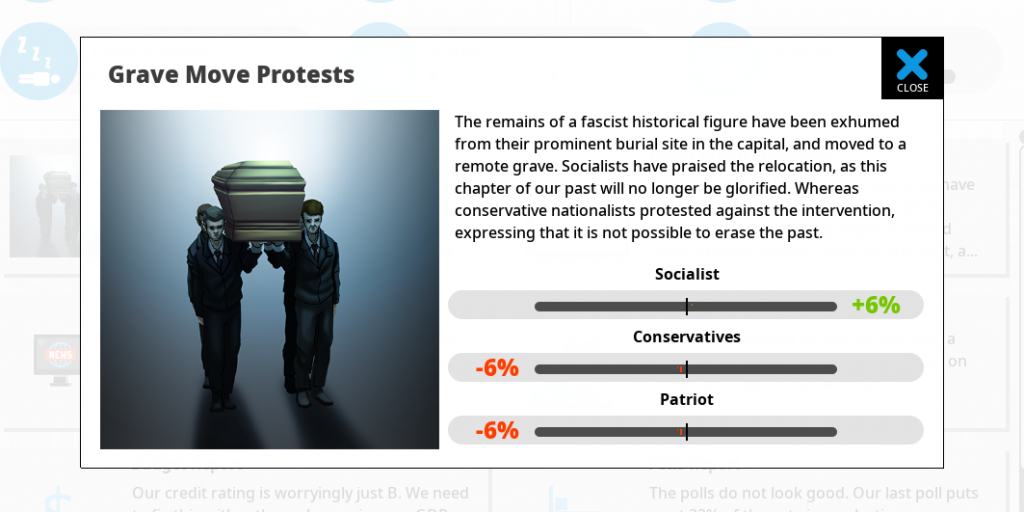As discussed in an earlier blog post, I think what democracy 4 needed was a way to bring home the true consequences of actions to the player. This has always been an area that was missing from the democracy 3 design. You can give the police machine-guns, you can legalize heroin, you can put in place all the apparatus of a police state, or a religious theocracy, and the only real consequences you see are some numbers going up and down.
Of course, the democracy games are known for being interesting complex simulations, not for whizz bang visuals or for feeling like ‘yuo are really there’. Thats a deliberate design decision, in that I would rather spend the time (and money) making a complex like graphics-lite sim than making a shallow, simple game with some 3D people doing limited things. Its a foolish indie developer indeed who thinks they can ever compete with triple-A studios in terms of graphics.
However, I think I can have some of that feeling of emotional resonance, just by using text, if the text is worded right, and if it fits within the style of the rest of the game. As a result, I’m introducing this new ‘media reports’ feature into the game. Here is an example:

These are new things that crop up on the next turn screen now and then. They are not called ‘events’ internally, so I’m avoiding that term here. An event is something like a change in your credit score or a factory closure, which has actual measurable consequences wwithin the simulation. They can be great news or disasters and can shift the simulation in a way you have to respond to. Here is an ‘event’:

By contrast, the media reports have no consequences whatsoever. They are simply putting into words the impact of decisions you have made (or in some cases not made, such as policies not implemented). The idea behind them is that they make you stop and think about the choices you have made, and have to accept thoughts like ‘Yeah, shes going to die because of my policy, but I guess thats acceptable’.
In the real world, this sort of stuff does happen. The media is generally rubbish at doing analysis and taking a broad view and educating the citizens on what is going on in an accurate way. I would be astonished if one in a hundred UK citizens have any idea what our GDP is, or even what our current unemployment rate is, or be sure if they knew if crime, and violent crime had gone up or down in the last 5 years, ditto pollution, or productivity.
Basically the media knows most people will not choose to take in data that way, so they pick ‘human interest’ stories that they think reflect broader trends. This is the classic case of the war reporter zooming in on a child’s teddy bear in some rubble. it tells us nothing about a war, apart from reminding us that children are affected too, but that can have a huge political impact.
So anyway, I now have a system for adding this to Democracy 4. Its basically a folder full of text files that contain data that describes the circumstances under which it triggers, and some text templates I can populate with citizens names (so they will be suitably local). Example:
[config]
Name = labourlaws
Text = "A special report tonight on the closing down of one of our oldest manufacturing
businesses.
between her tears, CEO [FEMALEFULLNAME] tells us how heartbreaking it is for the family
firm to close down.
'Its just impossible to run a business in this country with
the state of our [POLICYNAME]?' She told us. 'The unions are
running us into the ground. We cannot compete any more'."
Policy = "LabourLaws"
Type = MRT_POLICY_CONSEQUENCE
[conditions]
LabourLaws,1,0.65,1.0
GDP,1,0,0.6
This is a media report that triggers if labour laws is a policy currently implemented, and if its set somewhere between 65 and 100%. It also requires GDP to be below 60%. This is so that we don’t have a media event about a business closing when the economy is going super-well.
All thats required to add these is just some time and imagination, and some spell checking :D. Its just text, and there is no problem adding hundreds of them. The only reason the game is unlikely to actually ship with hundreds is that it means HUGE translation costs, because a proper professional translation is maybe $0.10 per word. So that media report is $6.70 to translate. This probably seems reasonable, but if we have 100 of these, it means $670 to translate them…
…into one language.
If we do the bare minimum for a strategy game (English, French, Italian, German, Spanish). Thats over $2,500. We definitely want to add Chinese, Russian, Portuguese to the game, and this pushes it close to $5,000 just for this feature. Its probably a tenth of the games text at most, and I anticipate a proper paid translation of the game to my target languages is going to cost $50-60,000 at this rate.
maybe I shouldn’t care about this, after all its a mostly text-based game, isn’t that an acceptable chunk of the games budget? Also I do know that a lot of indies (even big name successful ones) rely on fan-translations. I am tempted to consider this, because the professional costs are just crazy, and I’m not sure the quality is any different. My only concern is liability. I need to know the translation is correct, not some random angry political rant snuck into my game by someone else…. hmmm…
Oh BTW yes, we will eventually support this being trivially moddable too, so people can add their own :D.